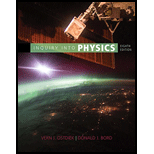
Concept explainers
To distinguish a particle made up of
Answer to Problem 24P
There is a difference of baryon number and strangeness for the
Explanation of Solution
Introduction:
The baryon is a type of composite subatomic particle which consists of quarks and antiquarks.
The subatomic particles in baryon category are made up of up, down and strange quark.
Compare the particle composed of
- The baryon number of both combinations is different:
Baryon number for each quark is
So, Baryon number for
And Baryon number for
- The strangeness of both combinations is different:
Strangeness number for up, down, antiup and antidown quark is
So, strangeness number for
And strangeness number for
Compare the particle composed of
- The baryon number of both combinations is different:
Baryon number for each quark is
So, Baryon number for
And Baryon number for
- The strangeness of both combinations is different:
Strangeness number for up, down, anti up and anti down quark is
So, strangeness number for
And strangeness number for
- The fractional change of combination of quarks are different.
The fractional charge of Up quark is +2/3, while down, strange, and all have a charge of -1/3.
Total fractional charge of
Total fractional charge of
Conclusion:
Thus,
Want to see more full solutions like this?
Chapter 12 Solutions
Inquiry Into Physics
- Identical rays of light enter three transparent blocks composed of different materials. Light slows down upon entering the blocks.arrow_forwardFor single-slit diffraction, calculate the first three values of (the total phase difference between rays from each edge of the slit) that produce subsidiary maxima by a) using the phasor model, b) setting dr = 0, where I is given by, I = Io (sin (10) ². 2arrow_forwardA capacitor with a capacitance of C = 5.95×10−5 F is charged by connecting it to a 12.5 −V battery. The capacitor is then disconnected from the battery and connected across an inductor with an inductance of L = 1.55 H . (D)What is the charge on the capacitor 0.0235 s after the connection to the inductor is made? Interpret the sign of your answer. (e) At the time given in part (d), what is the current in the inductor? Interpret the sign of your answer. (f) Atthe time given in part (d), how much electrical energy is stored in the capacitor and how much is stored in the inductor?arrow_forward
 Modern PhysicsPhysicsISBN:9781111794378Author:Raymond A. Serway, Clement J. Moses, Curt A. MoyerPublisher:Cengage Learning
Modern PhysicsPhysicsISBN:9781111794378Author:Raymond A. Serway, Clement J. Moses, Curt A. MoyerPublisher:Cengage Learning College PhysicsPhysicsISBN:9781938168000Author:Paul Peter Urone, Roger HinrichsPublisher:OpenStax College
College PhysicsPhysicsISBN:9781938168000Author:Paul Peter Urone, Roger HinrichsPublisher:OpenStax College
 Principles of Physics: A Calculus-Based TextPhysicsISBN:9781133104261Author:Raymond A. Serway, John W. JewettPublisher:Cengage Learning
Principles of Physics: A Calculus-Based TextPhysicsISBN:9781133104261Author:Raymond A. Serway, John W. JewettPublisher:Cengage Learning University Physics Volume 3PhysicsISBN:9781938168185Author:William Moebs, Jeff SannyPublisher:OpenStax
University Physics Volume 3PhysicsISBN:9781938168185Author:William Moebs, Jeff SannyPublisher:OpenStax Glencoe Physics: Principles and Problems, Student...PhysicsISBN:9780078807213Author:Paul W. ZitzewitzPublisher:Glencoe/McGraw-Hill
Glencoe Physics: Principles and Problems, Student...PhysicsISBN:9780078807213Author:Paul W. ZitzewitzPublisher:Glencoe/McGraw-Hill





